 Our 2019 Sacred Sites Journeys Our 2019 Sacred Sites Journeys
Spiritual Pilgrimage to MALTA Is a GO!
On Saturday, October 12th our group of sacred travelers
from the USA, Canada and Australia will gather at our hotel in Valetta
for the beginning of our unique transformational journey!
TOUR REGISTRATION CLOSED ON SEPTEMBER 18, 2019.

MALTA - GENERAL INFORMATION & HISTORY
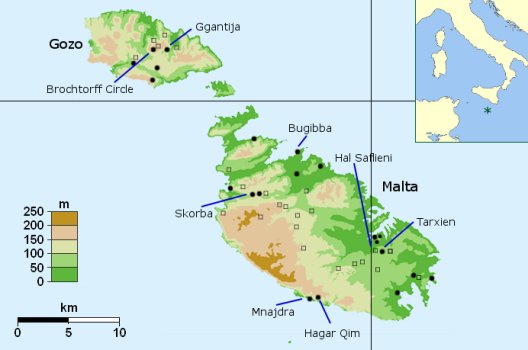
Sacred Temples of Malta
General Information
In the inset on the above map, the star indicates the location
of the Malta in the Mediterranean,
60 miles south of Sicily, the "boot" of Italy.
In case you've not heard of Malta, as many people haven't,
here's some information about
it.
Malta is the largest of the three major islands that constitute
the Maltese archipelago,
and is 95 square miles.
It's located east of its sister islands of Gozo and Comino.
In
October average temperatures is around 77 °F during the day and 64 °F at night.
Lovely weather!
Malta is one of the few places in Europe which is "green" all year round.
Native Maltese people make up the majority of the island.
However, there are minorities, the largest of which are British,
many of whom have retired
to Malta.
Thus English is spoken almost everywhere.
History
Humans have inhabited Malta since about 5200 BCE, when stone age hunters or farmers
arrived from Sicily.
Early Neolithic settlements were discovered in open areas and also in
caves, such as Ghar Dalam.
Around 3500 BCE, a culture of megalithic temple builders then
either supplanted or arose.
They built some of the oldest existing, free-standing
structures in the world in the form of megalithic temples,
such as those at Hagar
Qi and
Mnajdra.
After 2500 BCE, Malta was depopulated but soon became the home of Bronze Age
settlers.
They built first fortifications in Malta.
Being an island and thus a natural crossroads in the sea, Malta was later ruled by the
Phoenicians,
Carthaginians, Romans, Byzantines and Arabs before it was occupied by the
County of Sicily in 1091.
It then became part of the Kingdom of Sicily until it was given to the Order of Saint
John,
also known as the Knights of Malta, in 1530, along with Gozo and Tripoli.
The Order ruled Malta for over 250 years and built many great pieces of architecture,
including the capital city Valletta.
In 1565, The Order and the Maltese withstood a major Ottoman invasion.
In 1798 the French under Napoleon occupied Malta and ruled for a couple of months until
the Maltese rebelled.
In 1800, the British took control over Malta and it initially became a British
protectorate,
and a colony two years later.
The British ruled for about 150 years.
Malta became independent in 1964.
In 1974 the State of Malta became the Republic of Malta.
Malta joined the European Union in 2004 and adopted the Euro in 2008.
Esoteric History
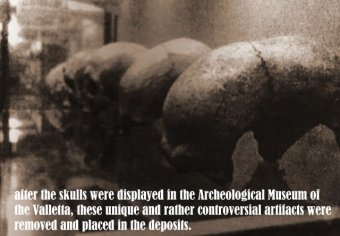
Legend has it that thousands
of years ago very tall lovers of the Goddess
with elongated skulls known as the Serpent
People
built megalithic temples on the summit of a ridge of towering mountains that united Africa
to Europe.
This ridge was eventually swallowed up when the immense wall of water that sunk Atlantis
poured through the Pillars of Hercules and then created the Mediterranean Sea.
The only temples to survive were those built upon the highest peaks, which then became
islands.
One of those peaks and its associated Goddess temples survives today as the Island of
Malta.
The Serpent People who built the temples of Malta designed them to
reflect the body of
their beloved Mother Goddess.
They covered them in Goddess spirals and then set “Fat Lady” images of Her
inside for worship.
Their temples were calendars in stone, perfectly aligned with many solar and stellar
positions,
as well as chambers for initiation into the Goddess Mysteries.

TOUR
DESCRIPTION
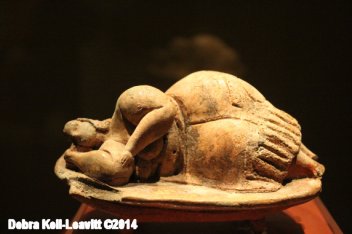
Join Featured Speaker Author
Mark Amaru Pinkham
and SSJ's Director & Meditation Facilitator
Andrea Mikana-Pinkham,
and our group of like-minded spiritual seekers
to explore and experience the
powerful transformational energies
of the
ancient megalithic Mother Goddess temples,
some of the oldest free-standing structures on Earth - over 7,000 years old!
Learn about the
ancient esoteric history of Malta,
from Mark Amaru,
author of the newly-revised & expanded popular classic
The Return of the Serpents of
Wisdom and seven other books
about this subject which attest to his passion
and unending research
about the Goddess Tradition and the ancient history of our planet.
Participate in
meditations
facilitated by Andrea to step back in “time”
as you connect with the still palpable energies of these amazing sacred sites
that were in
use when the Mother Goddess was
center stage in the hearts and minds of the people who built
them!
SPECIAL HIGHLIGHTS!
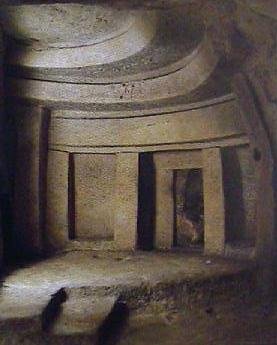
PRIVATE ENTRANCE for our group at the Hypogeum,
one of the greatest remaining structures from prehistory on our planet today!
Explore the mysterious ancient
“cart ruts”
that have been the subject of debate
for hundreds of years
as to their origin, form and function
- one of the most perplexing mysteries
of ancient megalithic building technologies of all time!
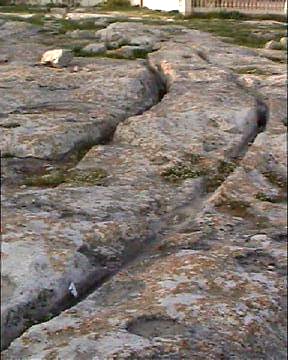

TOUR PERSONNEL
 Mark Amaru Pinkham
Mark Amaru Pinkham
Author, Shamanic Practitioner,
Researcher/Teacher of the Goddess Tradition
& Ancient Megalithic History and Director of
The Order & Mystery School of the Seven Rays
.
Mark
Amaru was the Featured Speaker on our first Sacred Sites Journey to
MALTA in 2013.
With Andrea, he
has been leading spiritual pilgrimages around the world since 1994.
He is the author of the
classic
The Return of the Serpents of Wisdom,
and six other books about
the ancient history of our planet,
attesting
to his passion and unending research about this subject.
During this spiritual
journey he will share his research with the group
in a formal
presentation " The Ancient History of Malta",
as well as informally as we visit the
sacred sites and
temples.
Mark
is a
longtime avid
researcher, supporter and
practitioner of the Goddess Path.
He is also a trained Shamanic Practitioner
and Founder/Director of
The Order and Mystery School of the Seven Rays.
From Mark Amaru:
My life has been devoted to traveling to those places around the globe whose past history
and purpose have become ongoing enigmas. Malta is one of those places. Phoenician sailors arrived there
around 800 BCE and found the island covered with abandoned rock temples in the shape of the universal Goddess.
Within these megalithic enclosures they discovered elongated skulls and astronomical alignments
that perfectly predicted the annual positions of the Sun, Moon, and the Pleiades. But that was all.
The mystery of who built these enigmatic structures was never solved by the Phoenicians, nor has it been since.
Join us in October 2019 as we attempt to finally unlock the secret mysteries of Malta
through scientific examination and intuitive revelation. I believe that the time of KNOWING is upon us!
For more information about
Mark Amaru,
Click here
 Andrea Mikana-Pinkham
Andrea Mikana-Pinkham
Shamanic
Practitioner and Researcher/Teacher of the Goddess Tradition
and Ancient Megalithic History & Director of Sacred Sites Journeys
Andrea has led our groups to Malta in the past and is now returning to support YOU!
All are welcome!
Andrea
has been leading spiritual pilgrimages around the world since 1994. She is a
longtime avid practitioner of the Goddess Path. During this spiritual
journey she will assist you to connect with the powerful energies of the Goddess at Her sacred sites and
temples.
Andrea is a trained Shamanic Practitioner,
Reiki Master Teacher, and Co-Director of
The Order and Mystery School of the Seven Rays.
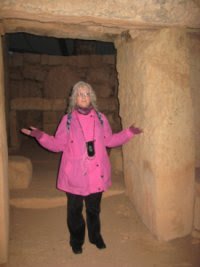 An Invitation from Andrea:
I invite you to join our diverse group of
spiritual seekers on this awesome spiritual pilgrimage in Malta. I've designed our
exceptional itinerary in order to give you the optimum experience at the ancient sites of
the Mother Goddess that we’ll explore and experience. I
will support you to connect with Her timeless Wisdom, as well as Her energies of love,
compassion and nurturing. As we explore the historical aspects of these sites you'll gain
an insight into how Her influence has continued to flow in these important areas
throughout time, influencing "Her-story" and thus our culture and civilization
of today. You will experience that the Goddess is still Alive, without and within! I'll be
honored to be with you to help facilitate your sacred travel experience and to support you
to have the transformation you seek. Blessings to you!
An Invitation from Andrea:
I invite you to join our diverse group of
spiritual seekers on this awesome spiritual pilgrimage in Malta. I've designed our
exceptional itinerary in order to give you the optimum experience at the ancient sites of
the Mother Goddess that we’ll explore and experience. I
will support you to connect with Her timeless Wisdom, as well as Her energies of love,
compassion and nurturing. As we explore the historical aspects of these sites you'll gain
an insight into how Her influence has continued to flow in these important areas
throughout time, influencing "Her-story" and thus our culture and civilization
of today. You will experience that the Goddess is still Alive, without and within! I'll be
honored to be with you to help facilitate your sacred travel experience and to support you
to have the transformation you seek. Blessings to you!
For more information about Andrea,
Click here

TOUR ITINERARY
(B = Breakfast, L = Lunch, D = Dinner)
Day 1.
Saturday, October 12. Arrive Malta. Group Meeting & Welcome Dinner (D)
Arrive in Malta today on your own. Please book your air to Malta - Airport
Code MLA. We encourage you to arrive early enough in the day so that you’ll
have a chance to rest before our afternoon and evening activities. -
After clearing Immigration and Customs look for SSJ’s local tour
representative in the Arrivals Hall with a sign with your name on it. He
will assist you to transfer to the hotel. NOTE: For those of you in the
group who are arriving early, this information is for you too!
Check in and rest a bit before our
evening meeting and dinner.
5:30PM –
Group Introductory Meeting in the hotel breakfast room facilitated by Andrea Mikana-Pinkham; Presentation by Mark Amaru
Pinkham - Malta and the Worldwide Megalithic Culture
6:45PM – Depart walking to the La Giarra Restaurant, 5 minutes away from the hotel for our Welcome Dinner. Return walking to the hotel aftewards.
Overnight Valetta.
The Barrister Hotel.
The Barrister is a new boutique hotel located in Valletta; it opened in January 2019, and is receiving rave reviews!
It's only a few minutes walk from the city center. Among the facilities are a restaurant, a 24-hour front desk and a concierge
service, along with free WiFi. The property also has a currency exchange for guests. All rooms at The Barrister Hotel have a flat-screen TV, air conditioning, a desk and an electric tea pot. In addition
rooms come with a closet, and are complete with a private bathroom equipped with a shower and a hairdryer. Daily breakfast is included.
Day 2. Sunday, October 13.
Cart Ruts, National Museum of Archaeology, Free Time; Optional Full Moon
Meditation (B)
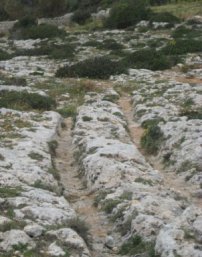 Breakfast
(continental buffet, i.e not cooked) at your leisure. Begins at 6:00AM Breakfast
(continental buffet, i.e not cooked) at your leisure. Begins at 6:00AM
9:00AM – Be in the lobby
ready to depart
9:15AM – We're off to explore the mysterious ancient
“cart ruts” that have been the subject of debate for
hundreds of years as to their origin, form and function - a most perplexing
mystery! Here on the islands of Malta and Gozo they are the most famous and
numerous. Deep ruts, tracks and grooves left in the limestone in such
numbers, variety and confusion leave more questions than answers. On Malta
there are cart ruts going off high cliff tops, while some are located on the
sea floor. At both Clapham Junction and San Gwann
Junction. there are many that intersect each other in total chaos.
The Clapham Junction site was nicknamed that after the complex railway
tracks of a London station. How were they formed? If they're made by humans,
who were they and why did they make them? We'll explore this longtime
mystery and see what conclusions we can come to for ourselves.
Lunch on your own. Each day our guide will take the group to a grocery store or cafeteria, delicatessen, food wagon or some other fast-food establishment where you'll be able to buy your lunch.
Then we’re off to the National Museum of
Archaeology, a Maltese museum of prehistoric artifacts that is
managed by Heritage Malta. The ground floor of the museum exhibits
prehistoric artifacts from the Maltese islands, from the Għar Dalam phase
(5200 BCE), the earliest appearance of settlement on the island, up to the
Tarxien phase (2500 BCE).
Early Neolithic Period Room
(5200–3800 BCE)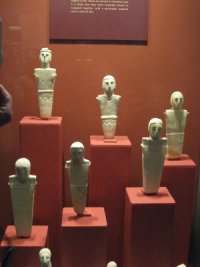
This room exhibits artifacts from the early Neolithic Period, including
decorated pottery from the Għar Dalam, Grey Skorba, Red Skorba and Żebbuġ
phases. Of particular importance are the Red Skorba figurines,
the earliest local representations of the human figure and the predecessors
of the statues of later temple periods. The exhibition features a
reconstruction of the rock-cut tombs that were a characteristic of the early
Neolithic period in Malta.
Temple Period Rooms (3800–2500
BCE)
These rooms show examples of architecture, human
representation and other items that date from the Mġarr, Ġgantija, Saflieni
and Tarxien phases of Maltese prehistory. The temples that were built at
this time are considered to be the world’s first free standing monuments and
are listed in the UNESCO World Heritage List.
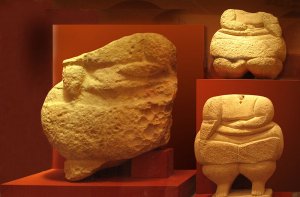 The museum exhibits numerous corpulent statues representing human bodies
unearthed from temple excavations, along with phallic representations. Are
these statues of the Mother Goddess, Fat Ladies, Deities or Priests?
The discovery of temple altars and corpulent human representations suggests
that some type of cult existed on the islands of Malta and Gozo in
prehistory. Given the corpulence of the statues it may be that the cult was
tied to a fertility rite. Fertility at this time must have been very
important since, apart from family growth, it also meant the reproduction of
crops and animals. We’ll explore the theories during our time here in this
sacred land.
The museum exhibits numerous corpulent statues representing human bodies
unearthed from temple excavations, along with phallic representations. Are
these statues of the Mother Goddess, Fat Ladies, Deities or Priests?
The discovery of temple altars and corpulent human representations suggests
that some type of cult existed on the islands of Malta and Gozo in
prehistory. Given the corpulence of the statues it may be that the cult was
tied to a fertility rite. Fertility at this time must have been very
important since, apart from family growth, it also meant the reproduction of
crops and animals. We’ll explore the theories during our time here in this
sacred land.
We return to hotel later afternoon. You have free time.
Time To Be Announced - Optional Full Moon meditation
with Andrea and Mark. The moon is full tonight at 11:07PM.
Dinner is on your own this evening. You can either eat at the hotel, or
stroll along the nearby streets where there are many restaurants.
Overnight Valetta.
The Barrister Hotel.
Day 3. Monday, October 14. Mgarr: Skorba and Ta Hagrat Temples; Mdina (B)
Breakfast at your leisure
8:30AM – Be in the hotel lobby ready to depart
8:45AM
– Depart the hotel.
Today we begin our exploration and experiences of the sacred Goddess temples
of Malta! After breakfast we depart by coach to the Village of Mgarr
(im-jarr), a small town in the southeast part of Gozo, a typical rural
village situated in an isolated region, to visit the temples of Ta
Hagrat and Skorba.
Our first stop is at the Skorba temples, megalithic remains on the northern edge of Zebbieg which
have provided detailed and informative
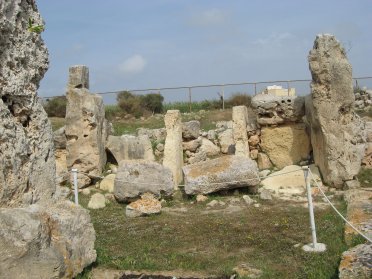 insight into the earliest periods of Malta's Neolithic culture. The site was only excavated in the early 1960s,
rather late in comparison to other megalithic sites, some of which had been
studied since the early 19th century. The site's importance has led to its
listing as a UNESCO World Heritage Site, a listing it shares with six other
megalithic temples in Malta.
insight into the earliest periods of Malta's Neolithic culture. The site was only excavated in the early 1960s,
rather late in comparison to other megalithic sites, some of which had been
studied since the early 19th century. The site's importance has led to its
listing as a UNESCO World Heritage Site, a listing it shares with six other
megalithic temples in Malta.
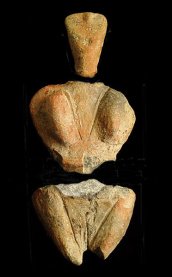 The remains on the site are a series of
megalithic uprights (one of them 3.4m high), the lowest course of the
temples' foundations, paving slabs with libation holes in the entrance
passage, and the torba or cement-like floor of a three-apse temple, a shape
that is typical of the Ġgantija phase. Unfortunately, the greater part of
the first two apses and the whole of the façade have been razed to ground
level. But the north wall is in a better state of preservation.
The remains on the site are a series of
megalithic uprights (one of them 3.4m high), the lowest course of the
temples' foundations, paving slabs with libation holes in the entrance
passage, and the torba or cement-like floor of a three-apse temple, a shape
that is typical of the Ġgantija phase. Unfortunately, the greater part of
the first two apses and the whole of the façade have been razed to ground
level. But the north wall is in a better state of preservation.
Originally,
the entrance of the temple opened on a court, but in later additions during
the Tarxien phase, the temple's doorway was closed off, with altars set in
the corners formed by the closure. East of this temple, a second monument
was added in the Tarxien phase, with four apses and a central niche. For a
period of roughly twelve centuries before the temples were built, a village
already stood on the site. Its oldest extant structure is the long straight
wall to the west of the temples’ first entrance. Deposits at its base
contained material from the first known human occupation of the island, the
Għar Dalam phase, including charcoal, which carbon analysis dated to 4850
BCE.
Andrea will facilitate a meditation to assist us to use our “psychic archaeology”
to tune into the lives of the Mother Goddess people who lived here in ancient times.
Next we visit the
Ta Hagrat temples, of which the larger temple dates from the Ġgantija phase
(3600–3200 BCE); the smaller is dated to the Saflieni phase (3300–3000 BCE).
 Major Temple: The Ġgantija phase temple is typically
trefoil, with a concave
façade opening onto a spacious semicircular forecourt. The façade contains a
monumental doorway in the center and a bench at its base. Two steps lead up
to the main entrance and a corridor flanked by upright megaliths of
coralline limestone. Three are placed on each side and support large
hard-stone slabs. The corridor beyond the entrance is paved with large stone
blocks placed with great accuracy.
Major Temple: The Ġgantija phase temple is typically
trefoil, with a concave
façade opening onto a spacious semicircular forecourt. The façade contains a
monumental doorway in the center and a bench at its base. Two steps lead up
to the main entrance and a corridor flanked by upright megaliths of
coralline limestone. Three are placed on each side and support large
hard-stone slabs. The corridor beyond the entrance is paved with large stone
blocks placed with great accuracy.
The corridor leads into a central
torba court, radiating three semi-circular chambers. These were partially
walled off at some time in the Saflieni phase; pottery shards were recovered
from the internal packing of this wall. The apses are constructed with
roughly-hewn stone walls and have a rock floor. Corbelling visible on the
walls of the apses suggest that the temple was roofed.
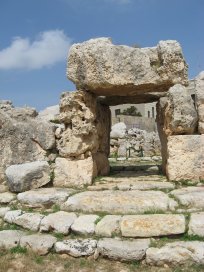 Minor Temple:
The Saflieni phase temple rests to the north and is 21 ft. long, and is
entered through the eastern apse of the larger temple. Smaller stones have
been used in its construction and it exhibits irregularities in design
considered archaic or provincial.
Minor Temple:
The Saflieni phase temple rests to the north and is 21 ft. long, and is
entered through the eastern apse of the larger temple. Smaller stones have
been used in its construction and it exhibits irregularities in design
considered archaic or provincial.
We’ll take time for meditation to connect with these ancient energies.
Optional Box Lunch. We’ll take time
to share with each other about our experiences at the Goddess temples this
morning.
After lunch we’re off to visit the village of Mdina, the old
capital of Malta. Mdina is a medieval walled town situated on a hill in the
center of
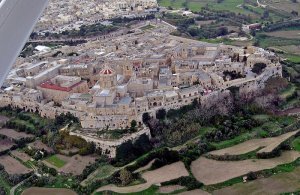 the island. Punic remains uncovered beyond the city’s walls
suggest the importance of the general region to Malta’s Phoenician settlers.
Mdina is commonly called the "Silent City" by natives and visitors. The town
is still confined within its walls, and has a population of just over three
hundred, but it is contiguous with the village of Rabat, which takes its
name from the Arabic word for suburb, and has a population of over 11,000.
Mdina is fascinating to visit for its timeless atmosphere as well as its
cultural and religious treasures.
the island. Punic remains uncovered beyond the city’s walls
suggest the importance of the general region to Malta’s Phoenician settlers.
Mdina is commonly called the "Silent City" by natives and visitors. The town
is still confined within its walls, and has a population of just over three
hundred, but it is contiguous with the village of Rabat, which takes its
name from the Arabic word for suburb, and has a population of over 11,000.
Mdina is fascinating to visit for its timeless atmosphere as well as its
cultural and religious treasures.
The history here goes back more than 4000 years. According to tradition it was here that in 60 CE that the
Apostle St. Paul is said to have lived after being shipwrecked on the
Islands. He supposedly resided inside the grotto known as Fuori le Mura
(outside the city walls) now known as St. Paul’s Grotto in Rabat. The late
17th-century St. Paul's Cathedral in Mdina stands on the traditional site of
the house of the governor Publius, who received St. Paul when he was
shipwrecked on Malta.
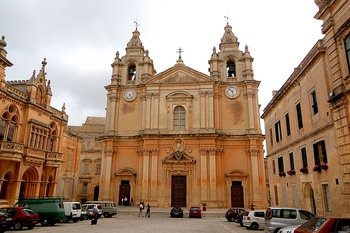 Mdina has had different names and titles
depending on its rulers and its role but its medieval name describes it best
– ‘Citta’ Notabile’: the noble city. It was home then, as now, to Malta’s
noble families; some are descendants of the Norman, Sicilian and Spanish
overlords who made Mdina their home from the 12th century onwards.
Impressive palaces line its narrow, shady streets. Mdina is one of Europe’s
finest examples of an ancient walled city and extraordinary in its mix of
medieval and Baroque architecture. During our tour we will stop at the
bastions of Mdina to admire the extensive views of Malta from one of the
highest points on the island.
Mdina has had different names and titles
depending on its rulers and its role but its medieval name describes it best
– ‘Citta’ Notabile’: the noble city. It was home then, as now, to Malta’s
noble families; some are descendants of the Norman, Sicilian and Spanish
overlords who made Mdina their home from the 12th century onwards.
Impressive palaces line its narrow, shady streets. Mdina is one of Europe’s
finest examples of an ancient walled city and extraordinary in its mix of
medieval and Baroque architecture. During our tour we will stop at the
bastions of Mdina to admire the extensive views of Malta from one of the
highest points on the island.
We return to the hotel later afternoon. You have free time tonight and dinner is on your own.
Overnight Valetta. The Barrister Hotel.
Day 4. Tuesday, October 15. Private Entrance at the
Hypogeum; Tarxien Temples; Group Meeting (B)
Breakfast at your leisure
8:00AM - Be in the hotel lobby ready to depart.
8:15AM
– Depart the hotel to the Hypogeum for our
9:00AM PRIVATE ENTRANCE The Hypogeum of Hal Saflieni, or underground cavity
carved from solid rock, is a unique monument and superb example of
architecture in the negative. Excavation has yielded a wealth of
archaeological material including pottery, human bones, personal
ornaments such as beads and amulets, little carved animals and larger
figurines.
When discovered it contained the bodies of over 7,000 people. Three
stories deep, it contains rock-cut features such as a 'speaking chamber', trilithons,
lintelled-doorways, a large cistern and a 'holy of holies' surrounded by 'embryonic'
chambers. The Hypogeum is one of the greatest remaining structures from prehistory.
Its pristine condition allows us to see the past through the eyes of our ancestors.
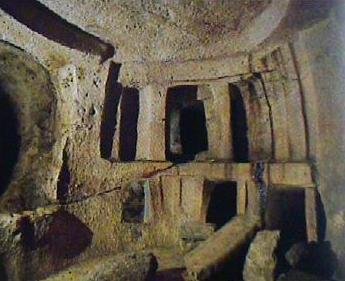 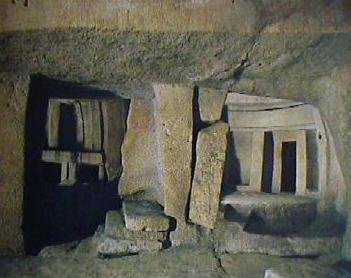 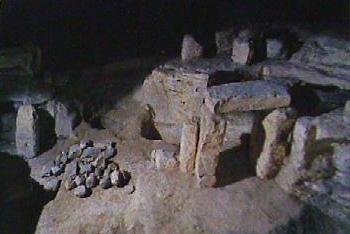
The purpose of the Hypogeum
is one of the most highly
debated in circles of megalithic architecture. This amazing and very
unique underground space offers us a rare glimpse at the prehistoric synthesis of
funerary, solar-worship and shamanic traditions. Perhaps the central chamber's several
small rounded cubicles carved into the walls were originally intended for 'living' people
as part of a ritual, in which they would have had to lie inside in a fetal position.
Traces of ergot have been found in the chamber called the 'cistern'; one of the physical
effects of ergot is to constrict bodily muscles, resulting in a forced fetal position. In
these small cubicles, echoes from the 'speaking' chamber reverberate into a rhythm that is
similar to the human heartbeat.
The entrance to the Hypogeum is through an unsuspecting doorway
in an unsuspecting street. It was first discovered in 1902, when builders broke
through whilst building foundations for a house. At first, the hole was covered over and
the event was kept quiet but word of the discovery soon got out and the museum authorities
moved in to protect it. Although underground, the Hypogeum was built near the top of a
natural hill overlooking the Marsa. The nearby Hal Tarxien, temple complex was built
higher still on the same face of the hill.
Although most of the Hypogeum is underground, the entrance to it was
built with megaliths, placed in what was presumably the natural entrance of the original
cave. The original entrance consisted of a large square opening in its center (a porthole
slab). This slab was later smashed and disposed of to make way for the new housing estate.
The first excavations in 1902 were performed by Fr. Magri, S.J. but
unfortunately shortly after its commencement, he left the island to take a missionary post
abroad where he died, leaving no records of his observations. Following this, the work was
passed on to Prof. Themi Zammit, who worked on it for the next five years. The 1990-1992
excavations suggested that there may have once been a monumental structure built directly
on top.
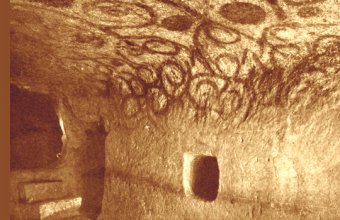 The speaking chamber has a hole known as the oracle hole in the wall carved
with a rounded interior surface. A design was painted in red-ochre onto the ceiling of the
chamber; it starts off on one side with a honeycomb design and transforms into a
collection of 'floral' spirals on the other. It's speculated that the oracle hole was part
of a ceremonial process. Words spoken into it make an echo which reverberates throughout
the hypogeum. The results of recent scientific study suggests that
the 6,000 year-old hypogeum could have been specifically designed to conduct and
manipulate sound to produce certain effects on the human brain. In this way,
people in the hypogeum experienced mood changes while listening to chanting.
Some scientists believe that certain sound vibration frequencies created when sound is
emitted within its walls are actually altering human brain functions of
those within earshot. According to a laboratory study, exposure to a tone within this
frequency, particularly at 110-111 hz seems to create a shift of
brain function, "turning on" an area of the brain that bio-behavioral
scientists believe relates to mood, empathy and social behavior.
The speaking chamber has a hole known as the oracle hole in the wall carved
with a rounded interior surface. A design was painted in red-ochre onto the ceiling of the
chamber; it starts off on one side with a honeycomb design and transforms into a
collection of 'floral' spirals on the other. It's speculated that the oracle hole was part
of a ceremonial process. Words spoken into it make an echo which reverberates throughout
the hypogeum. The results of recent scientific study suggests that
the 6,000 year-old hypogeum could have been specifically designed to conduct and
manipulate sound to produce certain effects on the human brain. In this way,
people in the hypogeum experienced mood changes while listening to chanting.
Some scientists believe that certain sound vibration frequencies created when sound is
emitted within its walls are actually altering human brain functions of
those within earshot. According to a laboratory study, exposure to a tone within this
frequency, particularly at 110-111 hz seems to create a shift of
brain function, "turning on" an area of the brain that bio-behavioral
scientists believe relates to mood, empathy and social behavior.
We’ll have a sound meditation here to support altering our consciousness to higher frequencies.
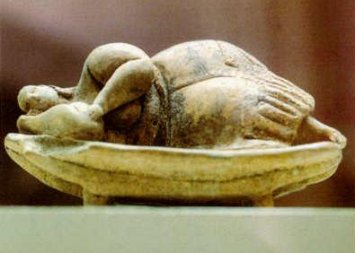
The hypogeum includes replicas of features from megalithic structures above ground on
Malta. It is possible to see both trilithons and 'doorways' in the same style as those
found in the numerous temples on the islands. It was also the place where the famous
terracotta figure called the Sleeping Lady was found in a cistern
containing numerous offerings. Two of these clay figurines were found in the Hypogeum. One
(right) in a sleeping position, and the other of similar design, but with the woman lying
face down. They were both found in the main chamber. Some researchers believe they represent humans involved in dream incubation.
 Afterwards we continue to the nearby Tarxien (tar-she-en) Temples,
which date from 3600-2500 BCE and are the most complex of all temple
sites in Malta. The temples are renowned for the detail of their carvings, which
include domestic animals carved in relief, altars,
and screens decorated with spiral designs and other patterns. The spiral
is the most common design in megalithic art on Malta, and indeed around the world.
Believed by some to represent eternity, the design is expressed in a wide variety of forms
across the islands and clearly had a significant meaning for the ancient Maltese peoples.
Of particular note is a chamber set into the thickness of the wall between the South and
Central temples, which is famous for its relief of two bulls and a sow.
The site seems to have been used extensively for rituals, which probably
involved animal sacrifice.
Afterwards we continue to the nearby Tarxien (tar-she-en) Temples,
which date from 3600-2500 BCE and are the most complex of all temple
sites in Malta. The temples are renowned for the detail of their carvings, which
include domestic animals carved in relief, altars,
and screens decorated with spiral designs and other patterns. The spiral
is the most common design in megalithic art on Malta, and indeed around the world.
Believed by some to represent eternity, the design is expressed in a wide variety of forms
across the islands and clearly had a significant meaning for the ancient Maltese peoples.
Of particular note is a chamber set into the thickness of the wall between the South and
Central temples, which is famous for its relief of two bulls and a sow.
The site seems to have been used extensively for rituals, which probably
involved animal sacrifice.
In the Bronze Age (2400-1500 BCE), Tarxien was reused as a
cremation cemetery.
The site lay hidden for centuries until its discovery in 1914, when farmers struck large
stone blocks while ploughing a field. Sir Temistocles Zammit, Malta’s first director
of museums, excavated the site in 1915-17.
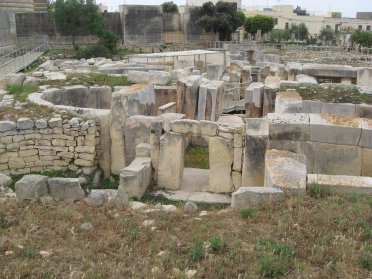

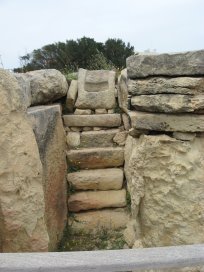
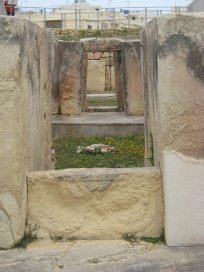
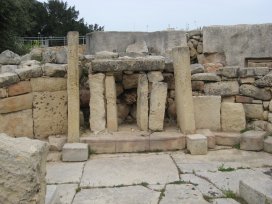
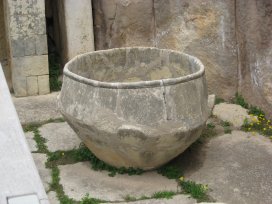
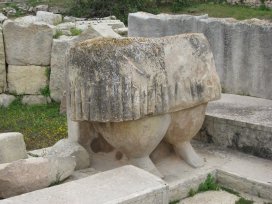 The Tarxien temple complex consists of four temples connected by a
square court. The temples each have separate entrances. Uniquely, the central
temple consists of six apses. This is the only known example of such a layout and it
represents a final phase in the long evolution of Maltese temple architecture. A narrow
staircase connects the central temple to the east temple.
The Tarxien temple complex consists of four temples connected by a
square court. The temples each have separate entrances. Uniquely, the central
temple consists of six apses. This is the only known example of such a layout and it
represents a final phase in the long evolution of Maltese temple architecture. A narrow
staircase connects the central temple to the east temple.
Fertility goddess figures (now in the national museum in Valetta)
discovered in the ruins indicate that the temples were dedicated to the Earth
Mother/the Mother Goddess, as were many Maltese temples. The most
famous of these figures is a sculpture of large hips with feet, dubbed the
"Fat Lady.
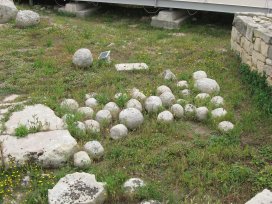
Spherical stones found at the site have provided a valuable clue as to how
the great stones of Malta's megalithic temples may have been moved into
place; some researchers believe they were rolled on the stones while being
towed with ropes. We’ll discuss this and other theories about the ancient
megalithic building techniques.
We’ll take time to meditate among the ancient stones and temples.
We return to the hotel. You have free time for lunch on your own. And time to explore more of the area!
5:00PM –
Group Meeting:
Presentation by Mark Amaru - The Ancient Goddess Tradition in Malta in the hotel
breakfast room.
You have free time. Dinner is on your own this evening.
Overnight Valetta. The
Barrister Hotel.
Day 5. Wednesday, October 16. Hagar Qim / Mnajdra Temples and Blue Grotto; Dinner at Ta' Marija Maltese Restaurant
(B/D)
Breakfast at your leisure
9:00AM – Be in the hotel lobby ready to depart
9:15AM – Depart the hotel to the temple of Hagar Qim
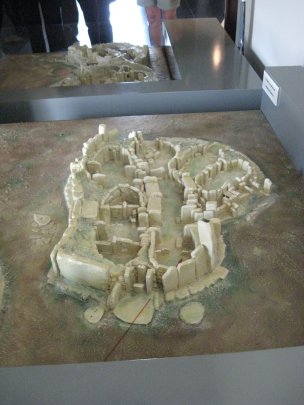
After breakfast we head to Hagar Qim (ha-jah-een), located on a hilltop overlooking the sea and the islet of Filfla. It’s the
best-preserved of several ancient limestone temples in Malta.
It dates from the Ggantija
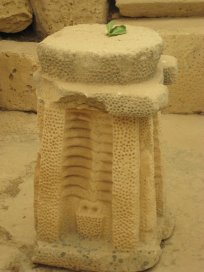 phase - which is about 3600 to 3200 BCE. Unlike most other Maltese temples, it is a single temple
rather than a complex of two or three. Other temple ruins stand a few feet away from the
main temple and the forecourt and facade follow the pattern typical
of temples across the Islands. Particularly noteworthy are the larger standing
stones at the corners, which are notched to take the second of the horizontal
courses above, which are traditional megalithic building techniques.
phase - which is about 3600 to 3200 BCE. Unlike most other Maltese temples, it is a single temple
rather than a complex of two or three. Other temple ruins stand a few feet away from the
main temple and the forecourt and facade follow the pattern typical
of temples across the Islands. Particularly noteworthy are the larger standing
stones at the corners, which are notched to take the second of the horizontal
courses above, which are traditional megalithic building techniques.
A stone decorated with spiral designs and a free-standing altar decorated
on all sides were found here. The right apse has an interesting inner enclosure made of
low stone slabs. The left apse has three high table altars and a low-standing pillar at
the end. Three steps up from the left apse lead to an additional chamber. In the outer
enclosing wall, the first upright stone behind the right-hand corner of the façade is one
of the largest of any temple, at about 21 ft. long and close to 20 tons in weight.
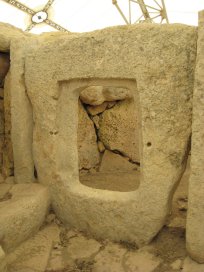
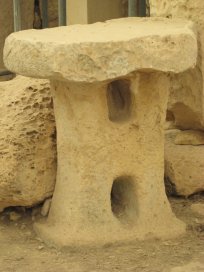
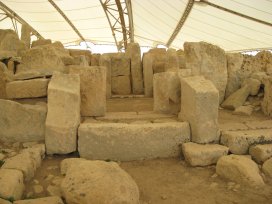
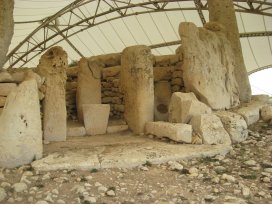
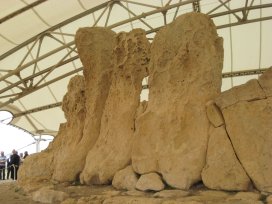
 Other related ruins have been uncovered near the main temple, and two Mother Goddess statues
discovered here are now in display in the national museum in Valetta.
Other related ruins have been uncovered near the main temple, and two Mother Goddess statues
discovered here are now in display in the national museum in Valetta.
Take some time for a meditation to connect once again with the Mother Goddess energies.
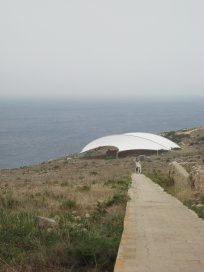 Then we head down the hill to Mnajdra (mna-ee-dra), a complex site consisting of three conjoined Neolithic temples
overlooking an oval forecourt. The first and oldest temple dates back to 3600-3200 BCE,
while the most impressive of the temples is the third, constructed between 3150-2500
BCE. This temple is perhaps the finest surviving on the Islands.
The masonry here shows intricate knowledge of building techniques and excellent
workmanship. And though Mnajdra is less than a mile downhill from the Hagar Qim temple
complex, the two complexes seem to have built at different times, and their relationship
is not known.
Then we head down the hill to Mnajdra (mna-ee-dra), a complex site consisting of three conjoined Neolithic temples
overlooking an oval forecourt. The first and oldest temple dates back to 3600-3200 BCE,
while the most impressive of the temples is the third, constructed between 3150-2500
BCE. This temple is perhaps the finest surviving on the Islands.
The masonry here shows intricate knowledge of building techniques and excellent
workmanship. And though Mnajdra is less than a mile downhill from the Hagar Qim temple
complex, the two complexes seem to have built at different times, and their relationship
is not known.
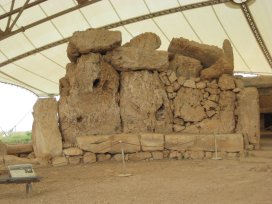
The first and oldest temple (northern/eastern) is a simple three-apsed structure dating from c.3600-3200 BCE,
not long after Ggantija was built. The small walls have been reconstructed but the small
uprights, with their pitted decoration, are original.
The middle temple is the largest and was the last to be built, closer to 2000 BCE.
It was inserted between the other two and set at a higher level, and is unusual in having a great 9 ft. high porthole slab
(now broken) as its main entrance, with a second doorway beside it.
To the left of the passage leading to the inner apses is an engraving of a temple facade.
The most impressive of the Mnajdra temples is the lower (southern/western) temple,
with a largely
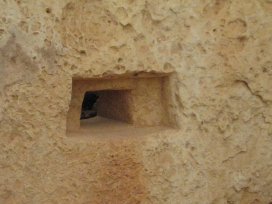 intact façade and bench constructed sometime between 3150 and 2500 BCE. Its corbelled
walls indicated the temple was roofed (as at Ggantija), and the stone slabs are decorated
with intriguing spiral carvings and dotted patterns. The porthole niche to the left is
especially impressive, framed in a trilithon and two strangely tapered megaliths on either
side.
intact façade and bench constructed sometime between 3150 and 2500 BCE. Its corbelled
walls indicated the temple was roofed (as at Ggantija), and the stone slabs are decorated
with intriguing spiral carvings and dotted patterns. The porthole niche to the left is
especially impressive, framed in a trilithon and two strangely tapered megaliths on either
side.
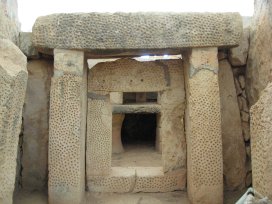
In the right-hand apse of the lower temple is a porthole doorway at the
top of a flight of steps giving access to an intramural chamber. An oracle hole opens from
that chamber and another oracle hole in a recess communicates with the back and outside of
the temple. Within the first side chamber is an altar on a double-hourglass shaped pillar.
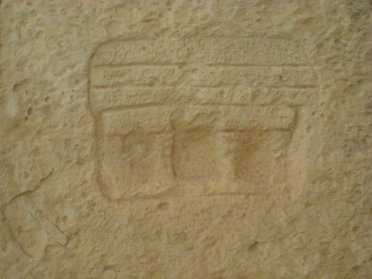
The lower temple is astronomically aligned. On the equinoxes the rays of
the sun pass directly through the temple’s main doorway and light up the main axis.
At the summer solstice, the sun lights up the edge of a megalith to the left of the
doorway, connecting the first pair of chambers to the inner chambers. At the winter
solstice, the same effect can be seen on the corresponding megalith on the right hand side.

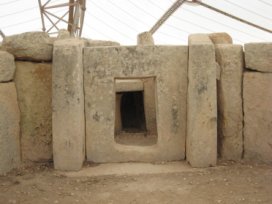
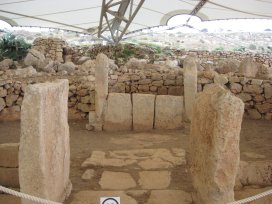
We'll have time for meditation to assist moving us into higher states of awareness.
Optional Box Lunch. Another time for sharing our morning’s experiences.
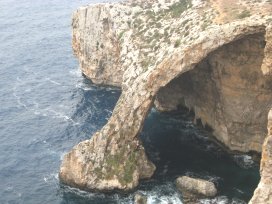
We then head to the south of the island to the area known as Wied Iz-Zurrieq or more commonly known as the Bue Grotto.
Weather permitting, we’ll have a short boat trip to the Grotto.
This natural picturesque grotto and its neighboring system of caverns
mirrors the brilliant phosphorescent colors of the underwater flora. From
Wied iz-Zurrieq lookout point we will also see the small island of Filfla,
which is uninhabited except for a unique species of lizards.
We return to hotel later afternoon.
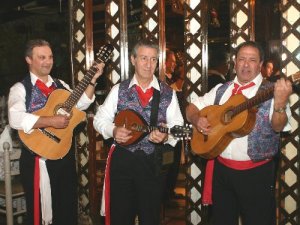 6:45PM – Be in the hotel lobby ready to depart.
6:45PM – Be in the hotel lobby ready to depart.
7:00PM – Group dinner at the Ta’ Marija Maltese restaurant located in the village of
Mosta for a lively and enjoyable evening of dinner and entertainment.
10:30PM - Return to the hotel.
Overnight Valetta. The
Barrister Hotel.
Day 6. Thursday, October 17. Gozo: Ggantija, The Citadel (B)
Breakfast at your leisure
8:00AM – Be in the hotel lobby ready to depart.
8:15AM – Depart the hotel for the ferry terminal. We take the ferry for a full day on
Gozo to visit more Goddess temples!
Our first stop is at the Ggantija (gii-gan-tii-ya) Prehistoric Temples in Xaghra (sha-ra).
These are the earliest of a series of megalithic temples
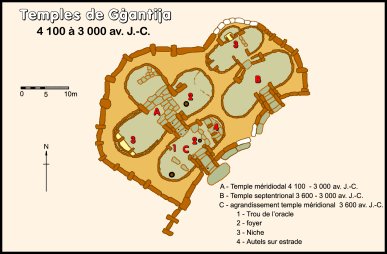 here. The ancient builders erected the two Ggantija temples during the Neolithic Age (c. 3600-2500 BCE, which makes these temples
more than 5500 years old and some of the world's oldest humanmade religious structures. Together with other similar structures,
these have been designated a UNESCO World Heritage Site.
here. The ancient builders erected the two Ggantija temples during the Neolithic Age (c. 3600-2500 BCE, which makes these temples
more than 5500 years old and some of the world's oldest humanmade religious structures. Together with other similar structures,
these have been designated a UNESCO World Heritage Site.
According to local Gozitan folklore, giants built these temples and used them as places of worship.
Evidence indicates there was an oracle here, as at the much-later Temple of Apollo at Delphi.
A priestess prophesied while in a trance, possessed by the spirit of the goddess. Ggantija also seems to have been a place
to pray for healing. In ancient times, the temples dedicated to the Mother Goddess at Ggantija drew pilgrims from across the island and even from North Africa
and Sicily.
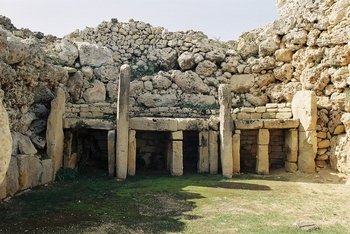
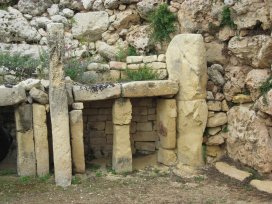
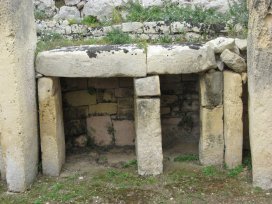
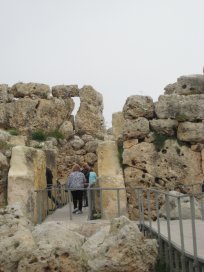
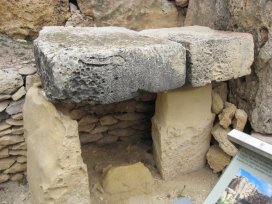
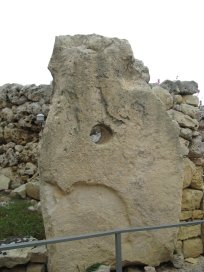
During our visit take time for meditation
to connect to the ancient Mother Goddess energies.
Optional Box Lunch. Another time for sharing our morning’s experiences.
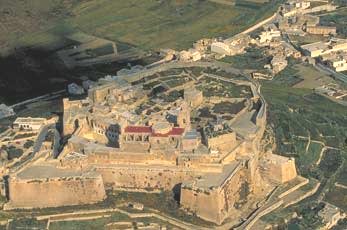 Then we visit the medieval part of the city of Victoria –
The Citadel,
an historic fortified city or castle. It's on Malta's tentative list of future World Heritage
Sites by UNESCO, who describe it as a small fortified town. The area is known to have been
first fortified during the Bronze Age c. 1500 BCE, was later developed by the Phoenicians
and continued development until, by Roman times, it had become a complex Acropolis. Up
until the 18th Century it was the only fortified refuge against attack for the inhabitants
of the island. The northern side of the Citadel dates back to the period of the Crown of
Aragon, while the southern flank, overlooking Victoria, was re-constructed between 1599
and 1603 by the Knights of St. John. The massive defensive stone walls of the
fortifications which rise above the town and were built by the Knights to protect the
village communities from foraging corsairs attempting to take slaves and threatening
invasion of Moslem forces fighting Christendom. In July 1551 a small Turkish force under
Dragut attacked the Citadel, which succumbed with little resistance. Those taking refuge
within its walls were taken as slaves and the castle reduced to ruins. Within its walls
lies a fine 17th century baroque Cathedral designed by Lorenzo Gafà, the
Maltese architect who also built the Cathedral of Mdina. Some researchers say that it lies
on the site where a Roman temple dedicated to Juno once stood. It is most
famous for the remarkable trompe l'oeil painting on its ceiling, which depicts the
interior of a dome that was never built.
Then we visit the medieval part of the city of Victoria –
The Citadel,
an historic fortified city or castle. It's on Malta's tentative list of future World Heritage
Sites by UNESCO, who describe it as a small fortified town. The area is known to have been
first fortified during the Bronze Age c. 1500 BCE, was later developed by the Phoenicians
and continued development until, by Roman times, it had become a complex Acropolis. Up
until the 18th Century it was the only fortified refuge against attack for the inhabitants
of the island. The northern side of the Citadel dates back to the period of the Crown of
Aragon, while the southern flank, overlooking Victoria, was re-constructed between 1599
and 1603 by the Knights of St. John. The massive defensive stone walls of the
fortifications which rise above the town and were built by the Knights to protect the
village communities from foraging corsairs attempting to take slaves and threatening
invasion of Moslem forces fighting Christendom. In July 1551 a small Turkish force under
Dragut attacked the Citadel, which succumbed with little resistance. Those taking refuge
within its walls were taken as slaves and the castle reduced to ruins. Within its walls
lies a fine 17th century baroque Cathedral designed by Lorenzo Gafà, the
Maltese architect who also built the Cathedral of Mdina. Some researchers say that it lies
on the site where a Roman temple dedicated to Juno once stood. It is most
famous for the remarkable trompe l'oeil painting on its ceiling, which depicts the
interior of a dome that was never built.
In the later afternoon we board the ferryboat to return to Malta and our hotel, arriving in the later afternoon.
Dinner is on your own.
Overnight Valetta. The
Barrister Hotel.
Day 7. Friday, October 18. Free Day; Farewell Dinner (D)
Breakfast at your leisure
You have free time today to explore more of Malta, especially the Valetta area, on your own.
7:30PM – We’ll gather at a local restaurant for our
Farewell Dinner. On our last evening
here we share our fond memories of our time in this ancient megalithic
Goddess land. Hopefully we’ve had many of our questions answered as to who
built these unique and amazing structures. And surely we will carry the
energies of the Great Mother Goddess home with us, to light our way always
!
Overnight Valetta. The
Barrister Hotel.
Day 8. Saturday, October 19. Depart Malta (B)
Breakfast at your leisure. Tour ends after breakfast.
Check out of the hotel and depart to the airport to check in
for your international flight.
This itinerary is subject to change due to conditions beyond our control.

TOUR INCLUSIONS
MAIN TOUR INCLUDES:
- 7 night’s accommodation at the 4-star boutique hotel, including taxes
- Daily Breakfast, 3 Dinners
- Air-conditioned motor coach
- All entrance fees to sites listed in itinerary
- All fees related to visiting special sites which are open only by appointment
- Round-trip ferry tickets to Gozo
- 24 hour emergency assistance by ground operator support staff
- Pre-Paid Gratuities
SPECIAL HIGHLIGHTS:
- Travel in a smaller group with other like-minded spiritual seekers
- Escorted by SSJs Director and Meditation Facilitator
Andrea Mikana-Pinkham
- Featured Speaker Author
Mark Amaru Pinkham
- Excellent English-speaking Tour Guide
- Private entrance for our group at the Hypogeum
- Explore the mysterious
"cart ruts"
NOT INCLUDED:
- Round-trip International Air to Malta (MLA)
-
Lunches
- Cost to obtain valid passport
- Meals not included in the itinerary; drinks at meals
- Any items of a personal nature such as laundry, drinks, internet service, telephone
calls. Any item that is not specifically detailed in the itinerary

TOUR PRICING
All
pricing listed is in US Dollars.
This Sacred Sites Journey to
MALTA is LAND ONLY. You are responsible to book your round-trip flights as per instructions in Day 1 of the tour itinerary
posted above.
Spiritual Pilgrimage to Sacred Temples of the Mother Goddess, October 12 -
19, 2019
Land
Only: Per Person, double occupancy
$2,399.00 - via check, money order or bank wire
$2,525.00 -
via credit card payment at PayPal.com
Single Room Supplement:
$719.00 - via check,
money order or bank wire
$757.00 - via
credit card payment at PayPal.com
ROOMMATES: Would you like to meet and make a new friend on your journey? If you're not
traveling on the journey with anyone you know, and would like for SSJ to try to match you
up with a suitable roommate, we'll be happy to try to do so.
Per our Terms and Conditions, we will hold the registration for the trip open
until 30 days before the departure date (or later if possible) in order to try to match
you with someone. If by that date we have not been able to do so, and there is no one to
share your room, you will be responsible to pay for the single supplement. If you would
like to be matched with a roommate, please register early.
NOTE: As of June 1, 2016 a fee of €0.50 per person per night is now collected from all hotels in Malta as an
Environmental Contribution, as per the Laws of Malta. €0.50 per person per night x 7 nights = €3.50 - This
amount will be added to your
room bill and will be paid by each client upon check out on the day you
leave. Thank you!

TOUR REGISTRATION
Our 2019 Sacred Sites Journeys
Spiritual Pilgrimage to MALTA Is a GO!
On Saturday, October 12th our group of sacred travelers
from Australia, Canada and the USA will gather at our hotel in Valetta
for the beginning of our unique transformational journey!
TOUR REGISTRATION CLOSED ON SEPTEMBER 18,
2019.
Questions? Email Andrea Mikana-Pinkham
at info@SacredSitesJourneys.com
Or call our office at
928 284-1429

IMPORTANT ANNOUNCEMENT!
Sacred Sites Journeys are smoke-free sacred travel experiences.
All forms of tobacco, as well as e-cigarettes are not allowed at any time.
Thanks for your cooperation.

If you'd like to receive our Monthly Sacred Sites
Journeys E-Newsletter
and
a Travel Discount Coupon that you can use to save a bit of $$
on this Sacred Sites Journey to
MALTA,
Sign Up Here!
Newsletters are sent out about
once a month.
New Subscribers will receive a Travel
Discount Coupon that you can use on one journey.
Exceptions noted on the
Sign Up
Page.
We will not sell or share
your information with any other company or individuals.
You can easily un-subscribe at any time.

NOTE: All photos and text on this webpage are the Copyright of Sacred Sites Journeys.
Sacred Sites Journeys is NOT affiliated
with any other sacred travel company.
Other sacred travel companies offering
spiritual pilgrimages similar to ours
are using our text, photos and some of our testimonials. We did not give them permission to do so.
We believe that karma is very efficient, and that those who are not in integrity
will swiftly reap the negative benefits of such actions.
Back
to top |
 SACRED SITES JOURNEYS
SACRED SITES JOURNEYS





















 The speaking chamber has a hole known as the oracle hole in the wall carved
with a rounded interior surface. A design was painted in red-ochre onto the ceiling of the
chamber; it starts off on one side with a honeycomb design and transforms into a
collection of 'floral' spirals on the other. It's speculated that the oracle hole was part
of a ceremonial process. Words spoken into it make an echo which reverberates throughout
the hypogeum. The results of recent scientific study suggests that
the 6,000 year-old hypogeum could have been specifically designed to conduct and
manipulate sound to produce certain effects on the human brain. In this way,
people in the hypogeum experienced mood changes while listening to chanting.
Some scientists believe that certain sound vibration frequencies created when sound is
emitted within its walls are actually altering human brain functions of
those within earshot. According to a laboratory study, exposure to a tone within this
frequency, particularly at 110-111 hz seems to create a shift of
brain function, "turning on" an area of the brain that bio-behavioral
scientists believe relates to mood, empathy and social behavior.
The speaking chamber has a hole known as the oracle hole in the wall carved
with a rounded interior surface. A design was painted in red-ochre onto the ceiling of the
chamber; it starts off on one side with a honeycomb design and transforms into a
collection of 'floral' spirals on the other. It's speculated that the oracle hole was part
of a ceremonial process. Words spoken into it make an echo which reverberates throughout
the hypogeum. The results of recent scientific study suggests that
the 6,000 year-old hypogeum could have been specifically designed to conduct and
manipulate sound to produce certain effects on the human brain. In this way,
people in the hypogeum experienced mood changes while listening to chanting.
Some scientists believe that certain sound vibration frequencies created when sound is
emitted within its walls are actually altering human brain functions of
those within earshot. According to a laboratory study, exposure to a tone within this
frequency, particularly at 110-111 hz seems to create a shift of
brain function, "turning on" an area of the brain that bio-behavioral
scientists believe relates to mood, empathy and social behavior.


























 6:45PM
6:45PM






